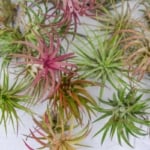Seedlings Suddenly Withering? It Might Be Damping Off Disease
It's called damping off and it’s every gardener's nightmare! What's the invisible force killing your seedlings? We explain what's going on, and how to prevent it from happening again.

Like most gardeners this time of year, you have already started growing lettuce, tomatoes, or other veggies and are getting excited about growing your own food. You plant your seeds in a seed starter mix, they begin to grow, sprouting up new life. But without warning, the newly-emerged seedlings are completely flattened, killed by an invisible source. Or, perhaps the seedlings never emerged from the soil in the first place. Damping off may be the culprit. But what is “damping off” and how can you prevent it?
What is “Damping Off?”
Damping off is a disease in young plants caused by the presence of certain pathogens and molds.
Plants affected by damping off often look as if they have been filled with water, and they may become mushy. The stems may turn black at the base, or become so thin that the plants cannot stand upright. Both stems and leaves may turn gray or brown, and the leaves will wilt. Most flowers and vegetable seedlings can be susceptible to the problem. It is most noticeable when the plants have just germinated and are sporting a tender stem and a set of cotyledons (seed leaves). Mature plants are less affected.
Can Plants Affected Be Saved?
Unfortunately, once seedlings have contracted damping off, there is usually no way to save them. (Occasionally some plants will survive, albeit with stunted growth. They may be prone to infestation by other diseases or pests, and may not produce flowers or fruit). Prevention is key.
Here are some tips to keep damping off from harming your plants this spring:
- Always disinfect your gardening tools and containers between plantings. The spores of the fungi that cause damping off can be moved by insects or even irrigation. Make sure the surfaces of your potting benches and even your work gloves are clean. Use a 1:10 solution of bleach and hot water to sanitize surfaces. (Rubbing alcohol or vinegar may be substituted for the bleach if desired). Rinse and dry thoroughly.
- Start fresh – Use potting soil not previously contaminated with the pathogens for damping off. In other words, don’t reuse the soil if you found damping off in your seedlings. The pathogens can remain in the soil indefinitely.
- Drainage – Potting soil should have good drainage; it should not contain a high clay content.
- Avoid using garden soil when planting in containers.
- Check the temperature. Every plant has an optimum soil temperature for germination. Sowing seeds in soil that is too cool may encourage damping off. Check the seed packets for the correct temperature needed for germination. If seeding indoors, use a heating pad to keep soil warm.
- Let there be light! Seedlings must be given enough light, at least 12 hours per day. Grow lights may be necessary if you are sowing indoors.
- Is it too damp? High humidity and overwatering can encourage infection. When watering, do not sprinkle water from overhead; water from the bottom whenever possible.
- Do not water with cold water. Use lukewarm water instead.
- Ensure that planting containers have holes at the base for drainage.
- Do not over-fertilize. In fact, seedlings do not need fertilizer until after several sets of true leaves have emerged. The seeds themselves have all the stored energy required to get the plants going initially.
- Get some air! Good air circulation is a must. You can set up a small fan nearby and use a very gentle setting to blow air onto your growing plants. Remove covers from propagation trays after the seeds have germinated to prevent excess humidity.
- Room to breathe – Do not sow seed too thickly.
- Buy pre-treated seed, if you feel comfortable doing so. Some seeds are inoculated with a fungicide to help prevent damping off.
With a little preventative maintenance and ongoing care, damping off is prevented before it has a chance to take hold and spread.
Have you had a run-in with damping off disease? Tell us in the comments below.
Sheryl Normandeau
Sheryl Normandeau, BA, is a Master Gardener and writer from Calgary, Alberta, Canada. Her articles and short stories have appeared in several international publications. She is the co-author (with Janet Melrose) of the Guides for the Prairie Gardener series.





